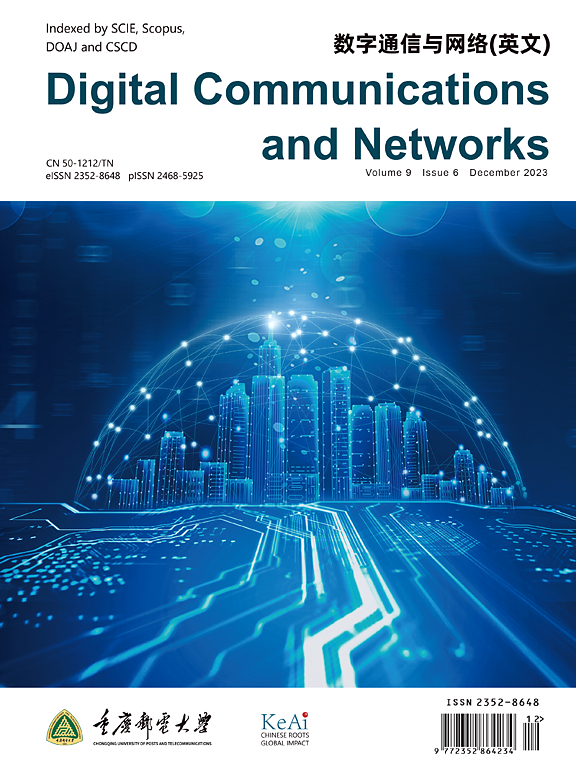支持 IRS 的 NOMA 通信系统:网络架构入门与未来趋势和挑战
IF 7.5
2区 计算机科学
Q1 TELECOMMUNICATIONS
引用次数: 0
摘要
非正交多址接入(NOMA)已被证明是第五代(5G)无线网络的有效多址接入方案。它在系统吞吐量、频谱效率、公平性和能效(EE)方面提供了更好的性能。然而,在传统的 NOMA 网络中,由于无线信道的随机行为,仍然存在性能下降的问题。为了应对这一挑战,智能反射面(IRS)的概念作为一种面向超 5G (B5G)网络的低成本智能解决方案而备受瞩目。本文介绍了基于这两种前沿技术(即 IRS 和 NOMA)集成的 B5G 无线网络建模入门。本文从三个方面对 IRS 辅助功率域 (PD) -NOMA 网络进行了深入的比较分析。首先,介绍了支持 IRS 的多配置 PD-NOMA 系统的系统架构,并将其与传统网络配置(即传统 NOMA、正交多址 (OMA) 和 IRS 辅助 OMA 网络)进行了比较。随后,从重要的性能指标(即单个用户的可实现速率、总和速率、遍历速率、EE 和中断概率)方面对这些网络配置进行了比较分析。此外,对于支持多天线 IRS 的 NOMA 网络,我们通过采用最先进的分支-还原-约束(BRB)方法的贪婪算法,利用了主动波束成形(BF)技术。通过与基准波束成形技术(即最小均方误差技术、零强迫波束成形技术和最大比率传输技术)进行比较,我们展示了 BRB 算法的最优性。此外,我们还展望了由 IRS 辅助的未来 NOMA 网络,即在 6G 无线网络中的各种潜在应用。这项工作为无线网络提供了一个通用性能评估工具包,重点关注 IRS 辅助的 NOMA 网络。这种比较分析为未来开发支持 IRS 的高能效无线通信系统奠定了坚实的基础。本文章由计算机程序翻译,如有差异,请以英文原文为准。
IRS-enabled NOMA communication systems: A network architecture primer with future trends and challenges
Non-Orthogonal Multiple Access (NOMA) has already proven to be an effective multiple access scheme for 5th Generation (5G) wireless networks. It provides improved performance in terms of system throughput, spectral efficiency, fairness, and energy efficiency (EE). However, in conventional NOMA networks, performance degradation still exists because of the stochastic behavior of wireless channels. To combat this challenge, the concept of Intelligent Reflecting Surface (IRS) has risen to prominence as a low-cost intelligent solution for Beyond 5G (B5G) networks. In this paper, a modeling primer based on the integration of these two cutting-edge technologies, i.e., IRS and NOMA, for B5G wireless networks is presented. An in-depth comparative analysis of IRS-assisted Power Domain (PD)-NOMA networks is provided through 3-fold investigations. First, a primer is presented on the system architecture of IRS-enabled multiple-configuration PD-NOMA systems, and parallels are drawn with conventional network configurations, i.e., conventional NOMA, Orthogonal Multiple Access (OMA), and IRS-assisted OMA networks. Followed by this, a comparative analysis of these network configurations is showcased in terms of significant performance metrics, namely, individual users' achievable rate, sum rate, ergodic rate, EE, and outage probability. Moreover, for multi-antenna IRS-enabled NOMA networks, we exploit the active Beamforming (BF) technique by employing a greedy algorithm using a state-of-the-art branch-reduce-and-bound (BRB) method. The optimality of the BRB algorithm is presented by comparing it with benchmark BF techniques, i.e., minimum-mean-square-error, zero-forcing-BF, and maximum-ratio-transmission. Furthermore, we present an outlook on future envisioned NOMA networks, aided by IRSs, i.e., with a variety of potential applications for 6G wireless networks. This work presents a generic performance assessment toolkit for wireless networks, focusing on IRS-assisted NOMA networks. This comparative analysis provides a solid foundation for the development of future IRS-enabled, energy-efficient wireless communication systems.
求助全文
通过发布文献求助,成功后即可免费获取论文全文。
去求助
来源期刊

Digital Communications and Networks
Computer Science-Hardware and Architecture
CiteScore
12.80
自引率
5.10%
发文量
915
审稿时长
30 weeks
期刊介绍:
Digital Communications and Networks is a prestigious journal that emphasizes on communication systems and networks. We publish only top-notch original articles and authoritative reviews, which undergo rigorous peer-review. We are proud to announce that all our articles are fully Open Access and can be accessed on ScienceDirect. Our journal is recognized and indexed by eminent databases such as the Science Citation Index Expanded (SCIE) and Scopus.
In addition to regular articles, we may also consider exceptional conference papers that have been significantly expanded. Furthermore, we periodically release special issues that focus on specific aspects of the field.
In conclusion, Digital Communications and Networks is a leading journal that guarantees exceptional quality and accessibility for researchers and scholars in the field of communication systems and networks.
 求助内容:
求助内容: 应助结果提醒方式:
应助结果提醒方式:


